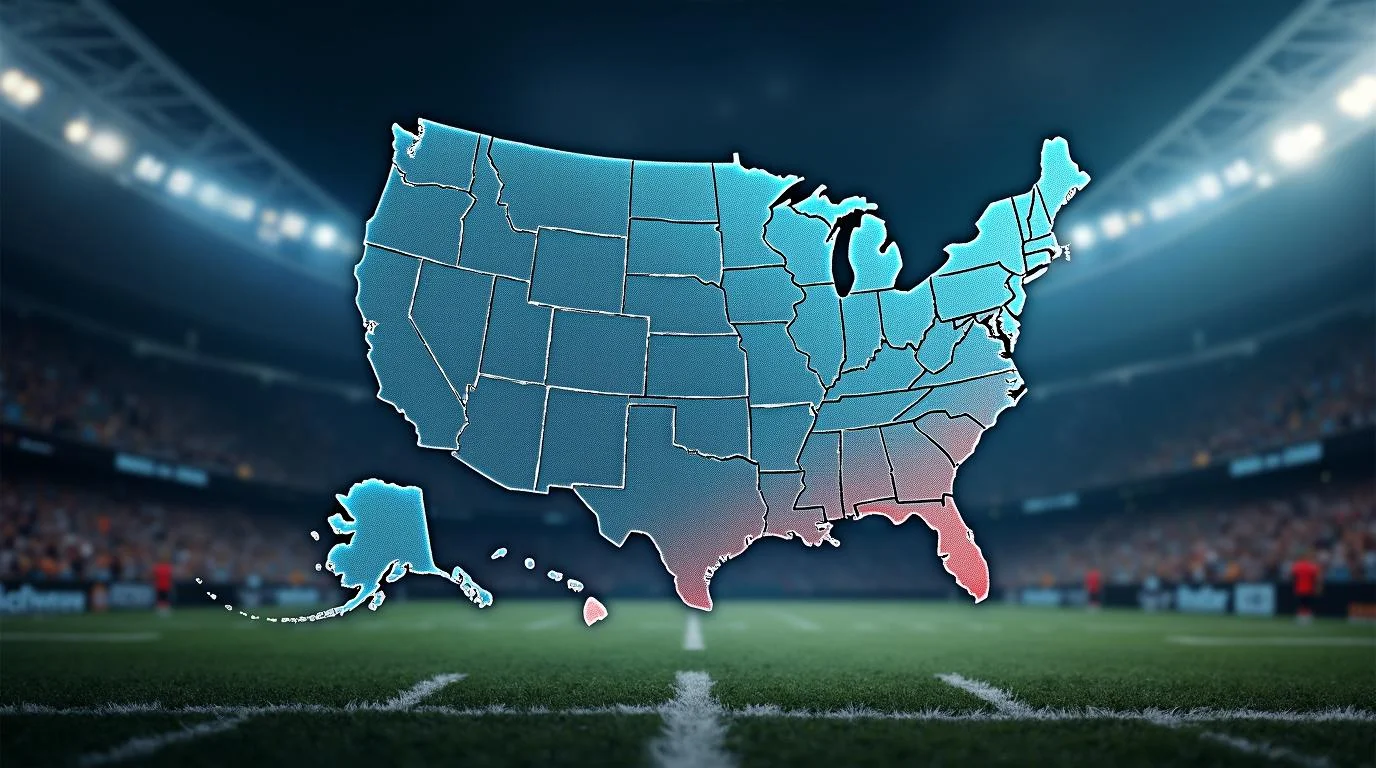How golf courses are ranked and rated
Selecting the US’ best golf courses is no small task, but the process behind the list ensures fairness, accuracy, and credibility. For instance, for Golf Magazine, a panel of 119 experts from a dozen nations undertakes this mission, using their extensive experience to evaluate and rank courses globally.
The ranking process
For Golf Magazine, panelists receive a ballot featuring 504 courses worldwide - and each panelist has seven months to complete their evaluations. Each course is categorized into one of 11 "buckets," with rankings spanning from the top three in the world to 250+ for consideration. In addition, panelists can nominate courses they believe deserve inclusion.
Each bucket is assigned points, and a golf course’s overall score is determined by dividing its total points by the number of votes it received. This simple yet transparent and straightforward approach ensures results that are widely respected across the golfing world. The main objective is simple - to maintain a ranking system that prioritizes quality without unnecessary complexity.
The role of the panelists
The panelists are carefully selected for their expertise in golf course architecture and global playing experience. With a diverse mix of players - from plus-handicaps to low double-digit handicaps - each course is assessed from multiple perspectives. Their combined insights create a well-rounded ranking that factors in both challenge and playability.
What matters most?
At the end of the day, unlike other rankings that follow the strictest assessment criteria, this entire process allows panelists to freely weigh different aspects of a course. That is why some prioritize playability and strategic design, while others focus on challenge or natural surroundings. This democratic approach results in a diverse and balanced list, celebrating golf courses that offer unique and memorable experiences worldwide. In the same vein, we have chosen the best golf courses using similar criteria.
The best golf courses in the US: the general list

1. Pine Valley Golf Club in New Jersey
Pine Valley Golf Club in New Jersey has been deemed the number one golf course – not only in America, but the rest of the world! It got its accolade from none other than Golf Magazine, which releases its yearly list of the Top 100 Golf Courses in the World. Interestingly enough, Pine Valley is one of the most exclusive golf clubs in the world – as proof of its exclusivity, it allowed only men as members as late as 2021, and women were only allowed to play on Sunday afternoons. The golf club also does not accept member applications – instead, it decides which members it wants to have.
But what distinguishes Pine Valley from the rest and makes it the absolute best? Well, Pine Valley has exceeded all expectations when it comes to its property, its greens, and its hazards. In fact, it has the most complex hazards and sophisticated greens ever found in the US, and it has one turf island interspersed with amazing routing, resulting in a unique landscape that’s every golfer’s dream. It was designed in 1918 by George Crump and Harry S. Colt, and it has achieved the number one rank for decades – it has never once budged from the top spot, and it has to be seen to be believed.
| Total Yardage |
Course Rating / Slope |
Holes |
Bunkers |
Water Hazards |
Fairway Characteristics |
Total Acreage |
Signature Hole |
Greens / Fairways |
| 7,181 yards |
75.6 / 155 |
18 |
200+ |
Minimal |
Narrow, tree-lined |
600 acres |
Par-3 10th over water |
Bentgrass / Bentgrass |
2. Cypress Point in California
Cypress Point has got to be the most beautiful and majestic location in Pebble Beach, and golfers who are lucky enough to play at Cypress Point enjoy the delightful walk around the golf course designed by Alister Mackenzie. The par-316 hole, which is the most famous (and most photographed) hole, is a marvel in itself, but Cypress Point has other dramatic highlights, including its coastline, its dunes, and its forests.
| Total Yardage |
Course Rating / Slope |
Holes |
Bunkers |
Water Hazards |
Fairway Characteristics |
Total Acreage |
Signature Hole |
Greens / Fairways |
| 6,524 yards |
73.5 / 136 |
18 |
46 |
5 |
Coastal, cliffside |
200 acres |
Par-3 16th over Pacific Ocean |
Poa annua / Poa annua |
3. Shinnecock Hills in New York
Shinnecock Hills in Southampton, New York was designed by architect William Flynn and boasts the distinction of being the main venue for a total of no less than five US Opens. Shinnecock Hills has the widest open spaces of them all, partly due to the fact that Flynn took years to finalize his design – it took him from 1928 to 1931 to finish the design of the course. If you ever get a chance to visit the course, you will see and appreciate the slow and steady work that went into building Shinnecock Hills, as it is evident in all its nooks and crannies.
| Total Yardage |
Course Rating / Slope |
Holes |
Bunkers |
Water Hazards |
Fairway Characteristics |
Total Acreage |
Signature Hole |
Greens / Fairways |
| 7,445 yards |
74.5 / 140 |
18 |
96 |
Minimal |
Open, wind-exposed |
300 acres |
Par-3 11th with ocean views |
Bentgrass / Bentgrass |
4. National Golf Links of America in New York
Another architectural marvel in Southampton built in 1911, the National Golf Links of America will astound you with its sheer scale and size. But that’s not all – the NGLA, as it is also called, is a strategically designed golf course with template holes that include the Redan 4th, the Alps 3rd, the Leven 17th, and the Short 6th. They were all copied from the United Kingdom by their architects, C.B. Macdonald and Seth Raynor.
| Total Yardage |
Course Rating / Slope |
Holes |
Bunkers |
Water Hazards |
Fairway Characteristics |
Total Acreage |
Signature Hole |
Greens / Fairways |
| 6,873 yards |
73.6 / 137 |
18 |
~300 |
Minimal |
Wide, links-style, strategic |
253 acres |
Par-4 14th “Cape” over water |
Bentgrass / Fescue |
5. Oakmont in Pennsylvania
The Oakmont in Pennsylvania was designed in the year 1903 by Henry Fownes, and this course isn’t the prettiest in the bunch – but it sure beats the others when it comes to the views and greens, especially from the hill on hole 15. It’s true that the landscape looks as barren as a desert, with no water features and few trees, but the greens are humongous and the putting surfaces are smooth and firm. The course is also known for being difficult – but it is definitely worth it.
| Total Yardage |
Course Rating / Slope |
Holes |
Bunkers |
Water Hazards |
Fairway Characteristics |
Total Acreage |
Signature Hole |
Greens / Fairways |
| 7,255 yards |
77.5 / 147 |
18 |
175 |
1 |
Tight, fast |
250 acres |
Par-4 3rd with Church Pews |
Poa annua / Bentgrass |
6. Sand Hills in Nebraska
Sand Hills in Nebraska was built in 1995, and although the course is relatively new, it has already caught many a player’s eye with its all-natural appeal. It has all the markings of an outstanding course, from the fairways to the sandy dunes and the prairie grass to the bunkers – it gives you the impression that the sea is near, even though you’re in Nebraska! Ben Crenshaw and Bill Coore, the architects, went all out, and the design is minimalism at its finest.
| Total Yardage |
Course Rating / Slope |
Holes |
Bunkers |
Water Hazards |
Fairway Characteristics |
Total Acreage |
Signature Hole |
Greens / Fairways |
| 7,089 yards |
75.0 / 144 |
18 |
80 |
None |
Rolling, natural |
8,000 acres |
Par-5 7th through dunes |
Bentgrass / Fescue |
7. Augusta National in Georgia
Augusta National was the vision of architect Bobby Jones and Alister Mackenzie, and it was designed and inspired by the Old Course at St. Andrews. Almost all holes at the Augusta National, which was actually built in 1933, lead safely back to the green, but there is also a more difficult and riskier route which many serious players appreciate. Along with this, the trees were removed just in time for the Masters in 2022, which made design aficionados welcome the change.
| Total Yardage |
Course Rating / Slope |
Holes |
Bunkers |
Water Hazards |
Fairway Characteristics |
Total Acreage |
Signature Hole |
Greens / Fairways |
| 7,475 yards |
78.1 / 137 |
18 |
44 |
6 |
Wide, undulating |
365 acres |
Par-3 12th over Rae's Creek |
Bentgrass / Bermuda |
8. Merion East in Pennsylvania
In Ardmore, Pennsylvania, stands Merion East, designed by Hugh Wilson. It was built in 1912, but what makes Merion extra remarkable is its diversity. It has short pars combined with huge pars that stretch nearly 200 yards, and the renowned par-4 11th is even separated by a creek. Meanwhile, par-4 16th has an abandoned quarry which players have to traverse through. Merion’s greens were recently expanded, and new holes have sprung up and irrigation features have resulted in more firmness.
| Total Yardage |
Course Rating / Slope |
Holes |
Bunkers |
Water Hazards |
Fairway Characteristics |
Total Acreage |
Signature Hole |
Greens / Fairways |
| 6,846 yards |
74.5 / 155 |
18 |
110 |
2 |
Tight, strategic |
126 acres |
Par-4 18th with quarry hazard |
Bentgrass / Bentgrass |
9. Fishers Island in New York
Another excellent golf course found in New York is Fishers Island, whose architect is the well-known Seth Raynor. Built in 1926 and expansive – and only accessible by air or by ferry! – this haven off the coast of Connecticut is the residence of the East Coast elite. The design is spectacular, to say the least – the course meanders down along the northeastern portion of the island, accompanied by gorgeous rolling hills and insane views of the Long Island Sound. Since 1989, Fishers Island has been on Golf Magazine’s list of the Top 100 courses.
| Total Yardage |
Course Rating / Slope |
Holes |
Bunkers |
Water Hazards |
Fairway Characteristics |
Total Acreage |
Signature Hole |
Greens / Fairways |
| 6,615 yards |
72.7 / 134 |
18 |
~100 |
Minimal |
Coastal, open, wind-exposed |
150 acres |
Par-3 5th, overlooking ocean |
Bentgrass / Bentgrass |
10. Los Angeles Country Club – North Course
Los Angeles North, built in 1927 and designed by architect George C. Thomas Jr., was restored by Gil Hanse and his team in 2010. Needless to say, it is better than ever, with relocated and reshaped bunkers, widened fairways, and a barranca that was brought back into the landscape as a strategically-placed hazard. There is a perfect sense of balance and place at Los Angeles North, but it is also known for its one-shot holes that continue to challenge any player.
| Total Yardage |
Course Rating / Slope |
Holes |
Bunkers |
Water Hazards |
Fairway Characteristics |
Total Acreage |
Signature Hole |
Greens / Fairways |
| 7,423 yards |
75.9 / 143 |
18 |
60+ |
Minimal |
Wide, rolling, barranca features |
~320 acres |
Par-3 11th, overlooking city skyline |
Bentgrass / Kikuyu |
What are the main differences between public and private: and which is better?
Now that you have a better idea of the golf courses to visit – and if you’re in the area of a top 10 golf course, there’s no better time than the present to sneak a peek (and maybe get a glimpse of famous golfers and insiders like Lou Monaco at the same time)! But while golfers have the option of playing on public or private golf courses as each offers unique experiences, we will attempt to answer another age-old question: which one is better? Whether you’re a casual golfer or a dedicated enthusiast, understanding the key differences can help you decide which is best for you.
Public golf courses: accessibility and affordability
Public golf courses are open to everyone, hence the name – which means you don’t need a membership to play. They are also often operated by local municipalities or private businesses and are generally more affordable than private clubs.
The main advantages of public courses include:
- Lower costs – You need only pay for the rounds you play.
- Varied skill levels – Many public courses cater to beginners and intermediate players.
- No membership commitment – Perfect for those who play occasionally.
However, keep in mind that public courses may have downsides - such as crowded tee times, less pristine course conditions, and fewer amenities compared to private clubs.
Private golf courses: exclusivity and luxury
On the other side of the spectrum lie private golf courses. Private golf courses require membership fees – and, moreover, many often have waiting lists. On the upside, they offer premium facilities, well-maintained fairways, and an exclusive atmosphere with fewer crowds.
The main advantages of private courses include:
- High-quality course conditions – Fairways and greens are always meticulously maintained.
- Less congestion – Tee times are easier to book with fewer players on the course.
- Additional perks – Access to clubhouses, restaurants, and professional coaching.
However, membership fees can be expensive, and you may be required to pay annual dues or additional fees.
Which is better?
Now comes the bigger question of them all: which is better? Well, the answer really depends on your budget, how frequently you play, and your own preferences. If you play casually, a public golf course is the best option for you. But if you play frequently and value exclusivity plus premium experiences, a private golf club may be worth the investment.
The best golf courses in the US for beginners
So we’ve finished delving into the top 10 golf courses in the US, but that is just a general list. If you really want to get down to brass tacks and acknowledge that you’re interested in the game and are willing to find out if it's got what it takes (and if you can hack it, that is), then you’d be wise to start off with a beginner golf course. And in the US, there’s plenty. There’s more good news: it’s relatively easy to start, because golf is a low-impact game with lots of benefits, not just physically, but mentally as well. It will also give you the best chance to socialize and mingle with your peers and expand your business network.
When looking for beginner-friendly courses, it’s best to look for those with the facilities and amenities suitable for a novice. These include specific areas that are designed for beginners or practice areas where you can improve your skills without fear. Also, courses that are beginner-friendly tend to have wider and shorter fairways, less complex greens, and fewer obstructions or hazards. You should also seek courses with a wide range of tee options – it lets you begin at a distance that is a good match for your level of skill. So, let’s get on with the game: here are the ten best golf courses for beginners/amateurs in the US.
1. The Players Championship Sawgrass in Florida
The Players Championship Sawgrass, or TCP Sawgrass, for short, is the home of the renowned Stadium Course, which, of course, plays host to The Players Championship in Ponte Vedra Beach, Florida. While there’s no denying that the Stadium Course is pretty challenging, TCP Sawgrass also offers the Dye’s Valley Course, which is more friendly to beginners with its broader fairways and fewer water obstructions. Aside from this, you will get a chance to enjoy the climate of sunny Florida!
2. Pinehurst Resort in North Carolina
Another world-famous beginner-friendly golf course is the Pinehurst Resort, located in Pinehurst, North Carolina. The resort has nine different courses, each one suitable for novices who are just learning the nuances of the sport. In addition, Course 1, which is often referred to as Pinehurst Nine, offers an excellent start. The course is also great for other reasons – it has wide fairways along with few hazards, and it has beautiful greens that are not complex. Furthermore, the resort has a tranquil ambiance that many golfers appreciate.
3. Torrey Pines Golf Course in California
The Torrey Pines Golf Course, which is in San Diego, California, is a beautiful course set along the Pacific Ocean coast. Of course, it is also known for being easy on beginners, particularly with its great, uncomplicated layout. Torrey Pines’ North Course is especially breezy, as it features few bunkers, simple greens, and broad fairways. More than this, you can take advantage of private lessons from Torrey Pines’ own LPGA and PGA professionals.
4. Bandon Dunes Golf Resort in Oregon
Bandon Dunes Golf Resort in Bandon, Oregon is a complete golfer’s haven, with its six courses which are linked and offer an awesome experience for beginners. It features the best ocean views, that is a given – but alongside this, its outstanding 13-hole course is ideal for any beginner just learning the ropes. Bandon Dunes Golf Resort is also known for its friendly and un-intimidating vibe, which allows you plenty of time to perfect your skills, especially with short games.

5. Kiawah Island Golf Resort in South Carolina
When it comes to luxury golf experiences, look no further than Kiawah Island Golf Resort. It offers a total of five courses, each one a championship course in its own right. For instance, you can start at the Cougar Point course, which has been designed by none other than Gary Player, and this 18-hole golf course exhibits the widest fairways, multiple options for teeing, and ample landing areas. Also, the resort gives golf lessons and schedules golf clinics made especially for beginners.
6. Tournament Players Club Myrtle Beach in South Carolina
Another South Carolina gem, TPC Myrtle Beach in Murrells Inlet is a premier destination for golfers, and although the course has one of the most challenging layouts, its South Creek Course offers something more forgiving for beginners. The South Creek Course at TPC Myrtle Beach features broad fairways, for one, but it also has few bunkers and water hazards when compared to the primary course.
7. Bethpage State Park Golf Course in New York
Bethpage State Park Golf Course in Farmingdale has a dreamy ambiance and a stunning backdrop. It is a public course found in Long Island, and it offers five courses of 18 holes each – and its Yellow Course is the most suited for beginners. It has all the features any beginner could want, including broad fairways, uncomplicated greens, and minimal hazards. Moreover, Bethpage State Park Golf Course offers golf lessons care of the Golf Channel Academy, and what’s more, the lessons allow kids and women, too.
8. Troon North Golf Club in Arizona
Troon North Golf Club in Scottsdale has transformed its dunes into two championship-grade golf courses. Its Monument Course is consistently ranked among its best courses, and it seems like it’s made especially for beginners. The Monument Course, for one, has the widest fairways well-suited to novices, but it also has plenty of landing areas as well as minimal carries. You will find yourself awed as well by the landscape – it’s surrounded by deserts and mountains, which gives it the most breathtaking views.
9. Pebble Beach Golf Links in California
Pebble Beach Golf Links in Pebble Beach is arguably one of the most famous golf courses known worldwide, and it can be found along the coast in California. What makes it spectacular is its diversity – and while Pebble Beach Golf Links is definitely the most challenging, it still makes it easy for beginners with the Hay Golf Course with nine holes. This short course offers a more relaxing experience coupled with the charm and innate beauty of the surrounding area.

10. Streamsong Resort in Florida
Streamsong Resort in Streamsong has the added distinction of being one of the Top 100 Golf Courses in central Florida, and it has three courses, all of which are championship golf courses. It is ideal for those who are just starting on their golf journey with its handy greens and expansive fairways, and of course, it is also known for its intense landscape filled with lakes and hills, which is the perfect complement to a perfect golfing adventure.
The best golf courses for intermediate golfers
Golf, as we all know, is a game of precision, patience, and continual growth. And for intermediate golfers - those who have moved beyond beginner status but aren't quite ready to challenge professional-level courses - the right golf course can make all the difference in honing your skills while still offering a fun and rewarding experience. The good news is that the United States once again does not disappoint when catering to an intermediate golfer’s needs – it boasts a wealth of golf courses catering to every skill level known to man. If most of these golf courses look familiar, that’s because most courses are designed to give all skill levels a good game, regardless if they’re beginners, intermediate players, or are already in the big leagues. Here, then, is a list of some of the best golf courses in the US that are perfect for intermediate players looking to elevate their game.
1. Pinehurst No. 2 in North Carolina
Pinehurst is known as one of the most iconic courses in the US, and it offers a unique blend of challenge and playability perfect for intermediate golfers. Designed by renowned architect Donald Ross, the course is famous for its undulating greens and strategically-placed bunkers. And while it has hosted a good number of championships, Pinehurst No. 2 is still accessible to those looking to improve their mid-level game. The fairways and the focus on short game strategy make it ideal for golfers ready to sharpen their putting and chipping skills.
2. Pebble Beach Golf Links in California
Though everyone has heard of Pebble Beach - it is often associated with professional tournaments, after all - it remains a favorite for intermediate golfers due to its breathtaking scenery and manageable fairways. The Pebble Beach course is known for its ocean views and holes on the cliffside that add both beauty, grandeur, and a hint of challenge to every shot. If you’re an intermediate player, you will appreciate the balance between technical shots and more understanding fairways, as it offers opportunities to test your skills without overwhelming difficulty.
3. TPC Scottsdale in Arizona
TPC Scottsdale is home to the famous Waste Management Phoenix Open, and TPC Scottsdale offers a course that’s both exciting and accessible to intermediate golfers – it is a veritable mid-range golfer’s dream. The Stadium Course, which we previously talked about, is known for its wide fairways and large-scale greens, and this allows players to focus on improving their approach shots and putting. Along with this, the desert landscape and well-maintained grounds create an enjoyable and stunning environment for those looking to refine their game without the pressures of an overly difficult course.
4. Bethpage State Park (Red Course) in New York
While Bethpage’s Black Course gets much of the crowd’s attention for its challenging layout, making it ideal for professional golfers, the Red Course is an excellent option for intermediate golfers. It is designed by A.W. Tillinghast, and the Red Course features broad fairways and a simpler design, making it less punishing for those who are still in the midst of refining their game. However, it’s not too easy - it still offers enough complexity to challenge players, particularly around the greens and in bunkered areas.
5. Bandon Dunes in Oregon
Bandon Dunes is another popular course that we’ve also previously discussed, and it’s a must-visit for any golf enthusiast - but it holds particular appeal for intermediate golfers. The resort features several courses, but if you’re at the intermediate level, the original Bandon Dunes course offers a perfect balance of challenge and playability. The links-style course, with its natural dunes and coastal winds, encourages creative shot-making while providing fairways that won’t overly penalize minor mistakes.
6. Harbour Town Golf Links in South Carolina
Harbour Town Golf Links at Sea Pines Resort in Hilton Head is another excellent course for intermediate golfers. Known for its narrow fairways and smallish greens, this course helps players work on their accuracy and course management. The iconic lighthouse backdrop adds to its charm, while the very design of the course challenges golfers to think strategically about every shot without it being excessively difficult.
The best golf courses in the US for professional golfers
Now that we’ve tackled the beginners and those in the mid-range, we move on to the pros. For professional golfers, the US is home to some of the most prestigious and challenging golf courses in the world – and these courses are not only famous for their rich histories and stunning landscapes, but are also known for their demanding layouts that test even the most skilled players. If you are in it to win it – if you’re chasing major titles (or whether you’re simply looking to experience the same fairways as the golf legends), here is what you have been waiting for: the best golf courses in the US for professional golfers.
1. Augusta National Golf Club in Georgia
Of course, no list of top golf courses made especially for the pros is complete without Augusta National, and it’s best known for being the iconic home of The Masters. As we mentioned earlier, it is designed by Bobby Jones and Alister MacKenzie – and Augusta National is known for its immaculate fairways, lightning-fast greens, and the infamous Amen Corner (which is holes 11-13), where many tournaments have been won or lost.
2. Pebble Beach Golf Links in California
Wouldn’t you know – Pebble Beach Golf Links has made it to the list once again, and it’s not hard to see why. Set along the coastline of California’s Monterey Peninsula, Pebble Beach is a bucket-list destination for professionals. The course has played host to multiple US Opens and is famous for its dramatic ocean views, particularly on the par-3 7th and the challenging 18th hole. With the narrowest fairways and even smaller greens, precision is key at Pebble Beach, making it a true test for even the most seasoned pros.
3. Pinehurst No. 2 in North Carolina
Once again, Pinehurst No. 2 dominates - designed by the legendary Donald Ross, Pinehurst No. 2 is renowned for its crowned, turtleback greens that demand exceptional short-game skills. The golf course has hosted several major championships through the years, including the US Open. To add to this, its natural, sandy landscape and strategic layout challenge players to think carefully about every shot, emphasizing accuracy over power.
4. Shinnecock Hills Golf Club in New York
Shinnecock Hills is one of the oldest golf clubs in the US, and as we have mentioned earlier, it is a quintessential links-style course that has hosted the US Open multiple times. With its undulating dunes and fairways, its thick rough fescues, and its gusty winds from the nearby Atlantic Ocean, it’s obvious that Shinnecock Hills demands strategic shot-making, mental toughness, and intense moves. Needless to say, the course’s timeless design continues to challenge the world’s best golfers.
5. Oakmont Country Club in Pennsylvania
Oakmont is often considered one of the most difficult courses in the country, and we can see why. Oakmont Country Club is a true test of skill - its lightning-fast greens, deep bunkers, and challenging layout make it a favorite for hosting US Opens. Aside from this, watch out for the infamous Church Pews bunker – it sits between the 3rd and 4th holes and is just one of many obstacles that can quickly turn a good round into a struggle.
6. TPC Sawgrass in Florida
Located in Ponte Vedra Beach and home to The Players Championship, TPC Sawgrass, which we also mentioned previously, is often referred to as the "fifth major." TPC Sawgrass is famous for its island green on the par-3 17th hole. This course was designed by Pete Dye, and the course features narrow fairways, hazards with strategic placements, and fast greens that demand the ultimate in accuracy and precision from every player. To add to this, the dramatic finishing holes make for an exciting conclusion to any tournament.
7. Whistling Straits in Wisconsin
The Whistling Straits golf course in Koler is a rugged, links-style course located along Lake Michigan. It has hosted multiple PGA Championships and a Ryder Cup, and it was designed by Pete Dye. Whistling Straits features over 1,000 bunkers and undulating fairways, but it also has stunning lake views. What makes it even more challenging is that the winds are unpredictable, adding an extra layer of difficulty, making it a true test for professionals.
These courses are more than just beautiful landscapes - they are battlegrounds where history has been made and legends have been born – and their mere presence is a true testament to anyone’s gold journey in the USA. For professional golfers, tackling these iconic courses is both a privilege and a challenge, offering a chance to test their skills against the toughest layouts the US has to offer. Whether it’s the rolling greens of Augusta or the wind-swept fairways of Whistling Straits, these courses embody the spirit of professional golf at its finest.

Well, there you have it - whether you're just starting out or you've been swinging your golf clubs for years, finding the right golf course is key to enjoying the game and honing your skills. Lucky for you, the US boasts a diverse range of golf courses, from the iconic Pine Valley in New Jersey to the scenic Cypress Point in California, and each course offers unique challenges and breathtaking landscapes. Courses like Shinnecock Hills and Augusta National are steeped in history and prestige, while modern gems like Sand Hills in Nebraska showcase innovative, minimalist design.
Of course, choosing the right course goes beyond just location or reputation - it’s about matching your skill level and personal preferences to the course’s features. Regardless if you prefer the exclusivity and tailored experiences of private clubs or the accessibility and charm of public courses, there is something indeed for everyone. Understanding how these courses are ranked, from architectural brilliance to playability and natural beauty, gives you deeper insight into what makes them special.
Ultimately, however, golf is as much about the journey as it is about the scorecard. So if you’re aiming to perfect your swing, explore new courses, or simply enjoy a day out on the greens, the US has no shortage of top-tier golf destinations to elevate your game. There is really nothing left to say but happy golfing!











_800x800.webp)



































